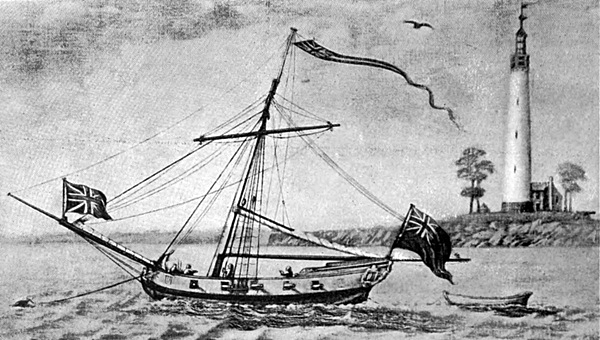Boston Light is a lighthouse located on Little Brewster Island in outer Boston Harbor, Massachusetts. The first lighthouse to be built on the site dates back to 1716, and was the first lighthouse to be built in what is now the United States. The current lighthouse dates from 1783, is the second oldest working lighthouse in the US (after Sandy Hook Lighthouse in New Jersey), and was the only lighthouse to still be actively staffed by the United States Coast Guard, being automated in 1998 though there are still volunteer keepers acting as tour guides]. The structure was designated a National Historic Landmark in 1964.[5]
http://en.wikipedia.org/wiki/Boston_Light
Check out this 1839 painting. Yes, that's the Boston Lighthouse in the background.

Around 1916.
 | ||||||||||||||||||||||||||||||||||||||||||
Description: Rising 89 feet above the rocky south side of Little Brewster Island, the white tapering tower of Boston Light deserves its description as the “ideal American Lighthouse.” Flanked by a white clapboard keeper’s dwelling, a picturesque oil house and a fog signal building, Boston Light stands sentinel over one of the oldest and most important harbors on the Eastern Seaboard. Its appearance, however, is only part of its charm, for its story reads like a Who’s Who of American History.
Fortunately the third keeper, John Hayes, survived long enough to make two significant improvements: he requested a gallery be built around the tower’s lantern room so he could keep the glass free of ice and snow, and he requested some sort of a gun “to answer Ships in a Fogg”. In 1719, America’s first fog signal— a cannon—was installed on the island where it remained until the early 1960’s, when it was moved to the Coast Guard Academy. In 1993, it was brought back to the island, where it is on display. Today in heavy fog a siren blasts out twice in rapid succession once a minute.
The damage to the lighthouse, though a grand gesture, was not a permanent or even very severe one, and the British soon sent repairmen. General Washington knew that the colonials could not allow the British to relight the tower, so he sent a second raiding party, this time 300 soldiers under the command of Major Benjamin Tupper. Arriving in the middle of the night on July 31, the Americans had the element of surprise and the aid of darkness. They quickly defeated the unprepared redcoats, destroyed all the work that had been completed by British carpenters, and set fire to everything that would burn. The raid would have been an unqualified success except that by then the tide had gone out, leaving the whaleboats they had used for transportation stranded on the beach. Major Tupper knew they had no time to waste before British reinforcements arrived, and ordered his men to push the boats with all their might back into the water. By the time they were again afloat, the British fleet had descended and would have defeated them had not an American artillery piece on nearby Nantasket Head opened fire. The trusty Minutemen lost only one member of their company, while the British suffered heavy casualties. General Washington praised the men as “gallant and soldier-like.”
In 1780, Massachusetts Governor John Hancock asked the legislature to fund a new tower. By 1783 the new 75-foot tower, designed “to be nearly of the same dimensions of the former lighthouse” was lit, and Little Brewster Island once again served as an aid to the many ships entering and leaving the harbor. The Commonwealth of Massachusetts ceded the lighthouse to the Federal Government in 1789. After several large cracks appeared in the structure in 1809, six heavy iron bands, three of which are now visible, were secured around the tower. In 1844 a spiral iron staircase was added, and in 1859 the tower’s height was increased from 75 feet to 89 feet. The tower remains virtually unchanged in appearance, but the changes in illumination mirror the development of lighting devices over the years. Initially the tower housed oil lamps; sixteen lamps were in place in 1789 when the Federal Government took possession. In 1811, the more effective Argand lamps, mounted on a rotating case, replaced the old oil lamps. When the tower was raised to 89 feet, it was also refitted with a 12-sided second-order Fresnel lens. Fortunately the lighthouse that had faced such drama during the early days of the American Revolution was too far north to suffer damage during the Civil War. It was not immune to succeeding conflicts, however. During both the War of 1812 and World War I, the light was dimmed so as not to be of use to enemy ships, and from 1941 to July of 1945 Boston Light was extinguished altogether. In 1948, Boston Light was electrified, and by 1989 every lighthouse in the United States had been automated except Boston Light. Perhaps fittingly, the first lighthouse on American shores was the last to succumb to modernization. With the combined efforts of preservation groups and Massachusetts Senator Edward M. Kennedy, funds were appropriated to keep Coast Guard staff at Little Brewster Island and turn the lighthouse into a living museum of lighthouse history. Boston Light did become automated on April 16, 1998, but Coast Guard crew still perform keeper duties. The two million-candle power light, visible for sixteen miles, can be seen shining twenty-four hours a day as a reminder of the inextinguishable American spirit. http://www.lighthousefriends.com/light.asp?ID=473 |




No comments:
Post a Comment